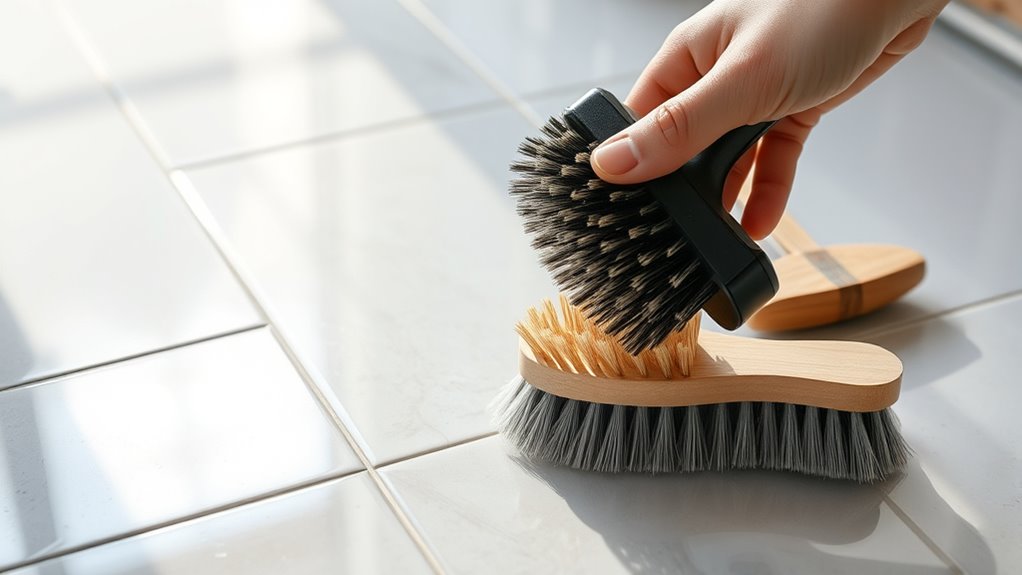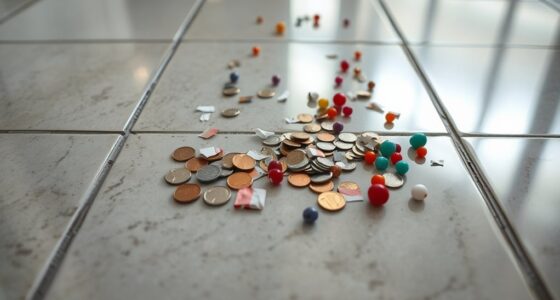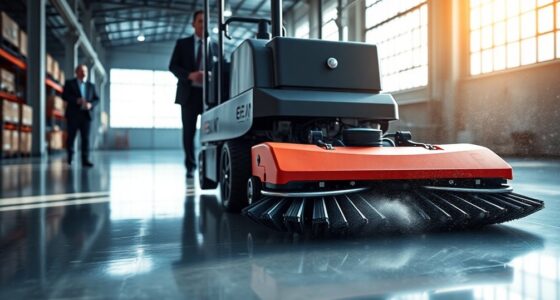For regular tile floor cleaning, soft bristles are your best choice because they gently loosen dirt without scratching the surface. Use them with a damp mop and mild cleaners for routine maintenance. Stiff bristles work better for deep cleaning stubborn stains and grout lines but can damage your tiles if used too often or improperly. To keep your floors looking their best, understanding when and how to use each type will make a big difference—keep exploring to learn more.
Key Takeaways
- Soft bristles are ideal for routine cleaning, preventing scratches and maintaining tile surface integrity.
- Stiff bristles are best for deep cleaning and grout stain removal, focusing on stubborn dirt.
- Using soft bristles regularly extends tile lifespan and reduces surface damage.
- Reserve stiff bristles for targeted, infrequent deep cleaning to avoid surface abrasion.
- Combining both types with proper techniques ensures effective, safe tile floor maintenance.

Are tile floors a smart choice for your home? They’re durable, stylish, and relatively easy to maintain, but keeping them spotless requires the right approach. When it comes to cleaning, your choice of tools and techniques makes a big difference. One of the most important decisions you’ll make is whether to use soft or stiff bristles, especially when scrubbing or mopping. The type of bristle can influence how effectively you remove dirt and grime without damaging the tile or grout.
Choosing between soft and stiff bristles is key for effective tile cleaning without damage.
If you’re tackling everyday cleaning, soft bristles are usually your best bet. They’re gentle enough to avoid scratching the surface while still being effective at loosening dirt. When combined with proper mopping techniques and suitable cleaning solutions, soft-bristled tools can keep your tile looking fresh and new. For routine mopping, start by sweeping or vacuuming to remove loose debris. Then, use a damp mop with a gentle cleaning solution—think a mix of warm water and a mild tile cleaner or a vinegar-based solution for natural cleaning. These cleaning solutions cut through grease and grime without leaving residue that attracts more dirt. When mopping, work in small sections, rinsing your mop frequently to avoid spreading dirt around. Be sure to change the water regularly, as dirty water can smear dirt back onto your floor.
On the other hand, stiff bristles come into play when you need to do a deep clean or tackle stubborn stains. These brushes or scrubbers are more abrasive, so they can dislodge dirt stuck in grout lines or heavily soiled areas. However, because they’re rougher, you should use them cautiously to prevent scratching or dulling the tile’s surface. Pair stiff bristles with a stronger cleaning solution, such as a commercial tile cleaner or a paste made from baking soda and water. Use these brushes sparingly, focusing on grout lines or textured surfaces where dirt tends to hide. Remember, aggressive scrubbing can damage your tile if done excessively, so always test in a small area first.
Ultimately, the key to successful tile cleaning is selecting the right bristle for the task at hand, combined with effective mopping techniques and quality cleaning solutions. Soft bristles maintain your tile’s shine during regular upkeep, while stiff bristles help you handle tougher cleaning jobs without harming the surface. Using the right tools in tandem with proper methods ensures your floors stay beautiful and durable for years to come. Incorporating a proper cleaning schedule can also extend the life and appearance of your tile floors.
Frequently Asked Questions
Which Bristle Type Is Better for Removing Stubborn Stains?
Stiff bristles are your best bet for stubborn stain removal on tile floors. They provide the extra scrubbing power needed to break up tough grime without damaging the surface. Soft bristles, while gentler, often lack the effectiveness required for stubborn stains. For ideal results, choose a brush with stiff bristles, but make sure to use appropriate pressure to avoid scratching your tiles.
How Often Should I Replace My Tile Floor Cleaning Brush?
You should replace your tile floor cleaning brush every three to six months, following a consistent maintenance schedule. Regular replacement guarantees peak cleaning performance, prevents bacteria buildup, and reduces wear and tear. Keep an eye on the bristles; if they become frayed, bent, or lose their stiffness, it’s time for a new brush. By maintaining this replacement frequency, you ensure your floor stays sparkling and your cleaning tools remain effective.
Can Stiff Bristles Damage Delicate Tile Surfaces?
Stiff bristles can damage delicate tile surfaces, especially if you scrub too hard, risking grout preservation and harming the aesthetic impact of your floor. You should opt for softer bristles around fragile tiles to prevent scratches and maintain the tile’s shine. Using gentle pressure helps preserve grout integrity and keeps your tiles looking their best, ensuring you don’t compromise your floor’s beauty or durability over time.
Are There Eco-Friendly Options for Tile Floor Cleaning Brushes?
Yes, eco-friendly options for tile floor cleaning brushes exist. You can choose biodegradable fiber brushes that break down naturally, reducing environmental impact. Recycled plastic brushes are also a great choice, as they repurpose materials and lower waste. Both options offer effective cleaning without harming the planet. When selecting a brush, look for those made from these sustainable materials to keep your cleaning routine environmentally responsible and efficient.
Do Different Bristle Types Work Better on Specific Tile Materials?
You’ll be amazed at how choosing the right bristle type transforms your cleaning game! Soft bristles excel on delicate tiles like glass or polished marble, preventing scratches and damage. Stiff bristles, on the other hand, cut through stubborn grime on rougher surfaces like textured ceramic or outdoor pavers. Always consider tile material compatibility to avoid mishaps and make your cleaning routine both effective and gentle. Your tiles will thank you!
Conclusion
Think of your tile floors as a garden path. Soft bristles are like gentle rain—carefully cleaning without disturbing the soil, perfect for delicate tiles. Stiff bristles are like a steady breeze—powerful enough to clear away stubborn dirt but riskier if overused. Choosing the right brush is like tending your garden—balance and understanding what your tiles need will keep your floors shining and lasting longer. Keep your cleaning approach in harmony with your tiles’ needs.









